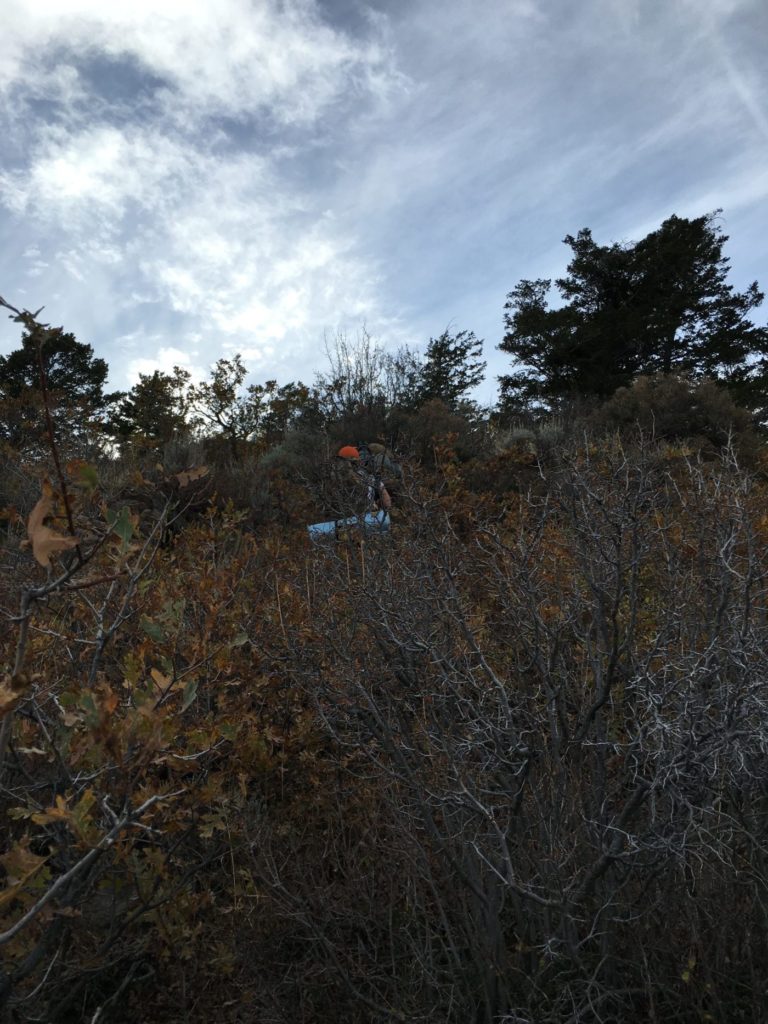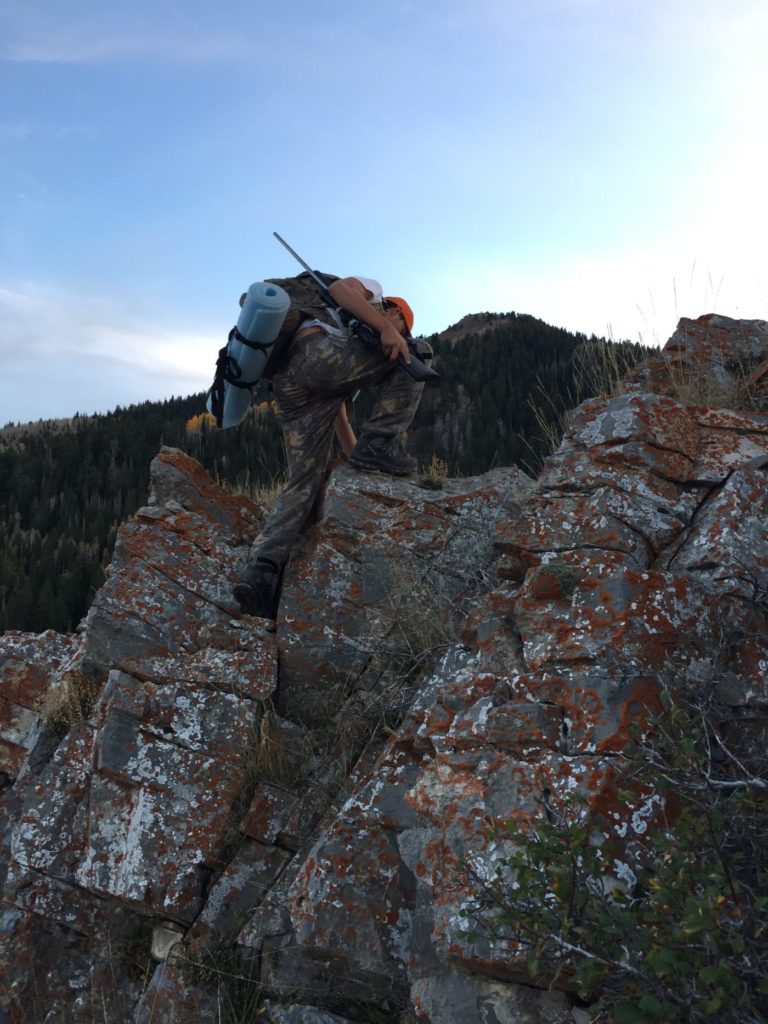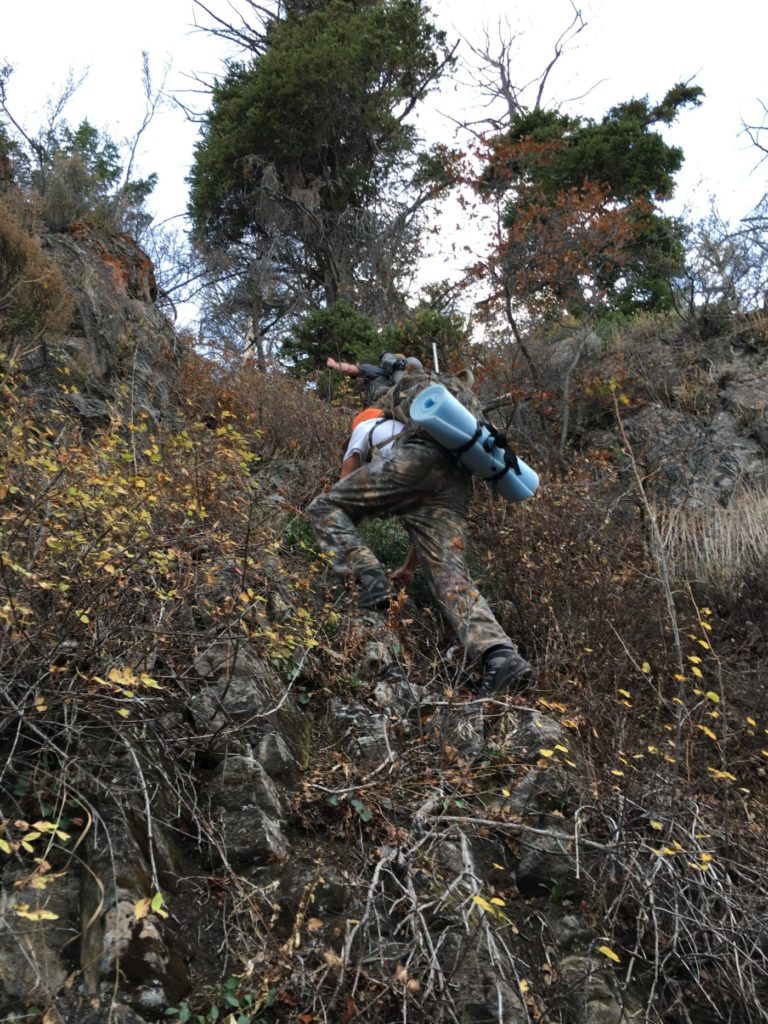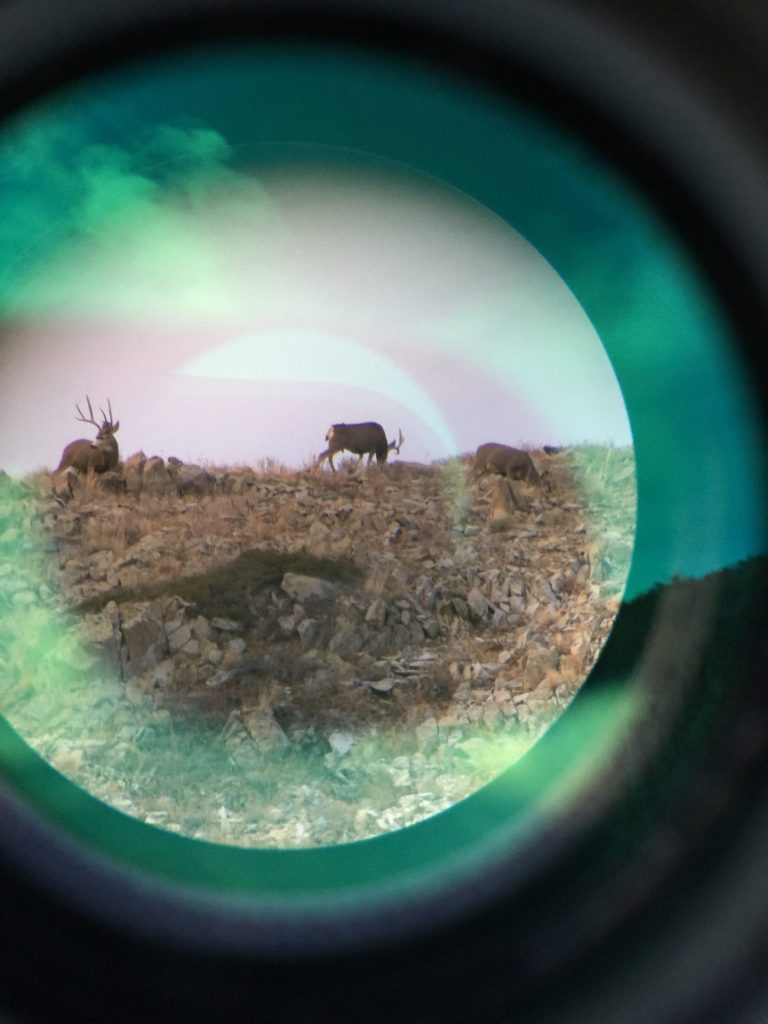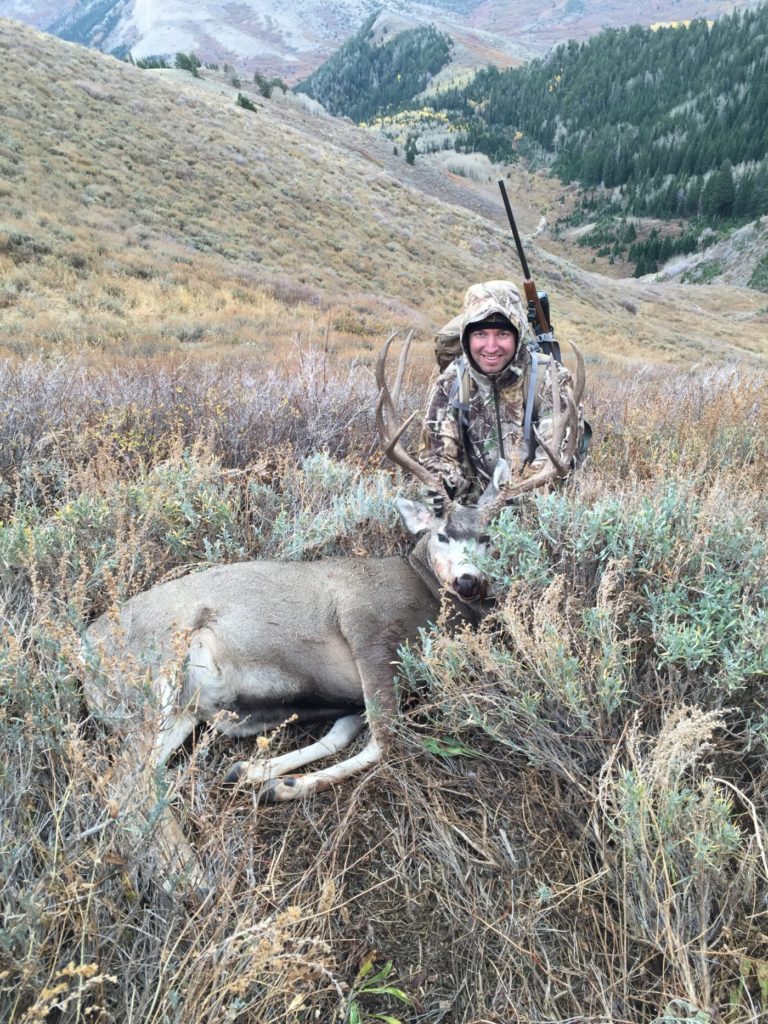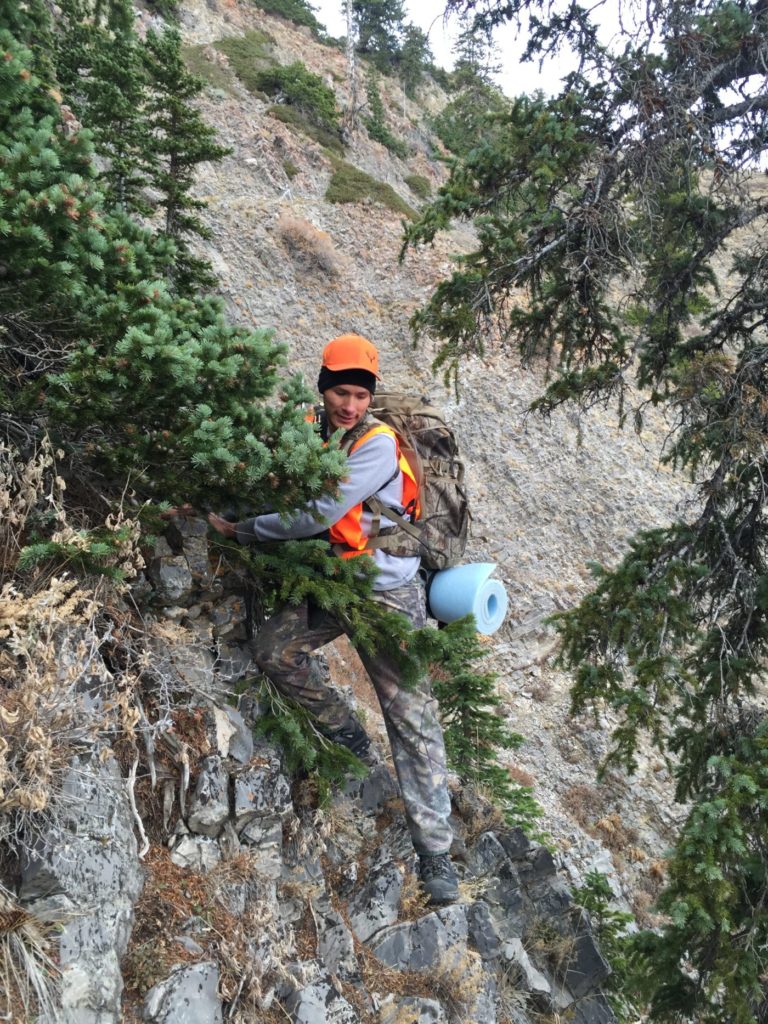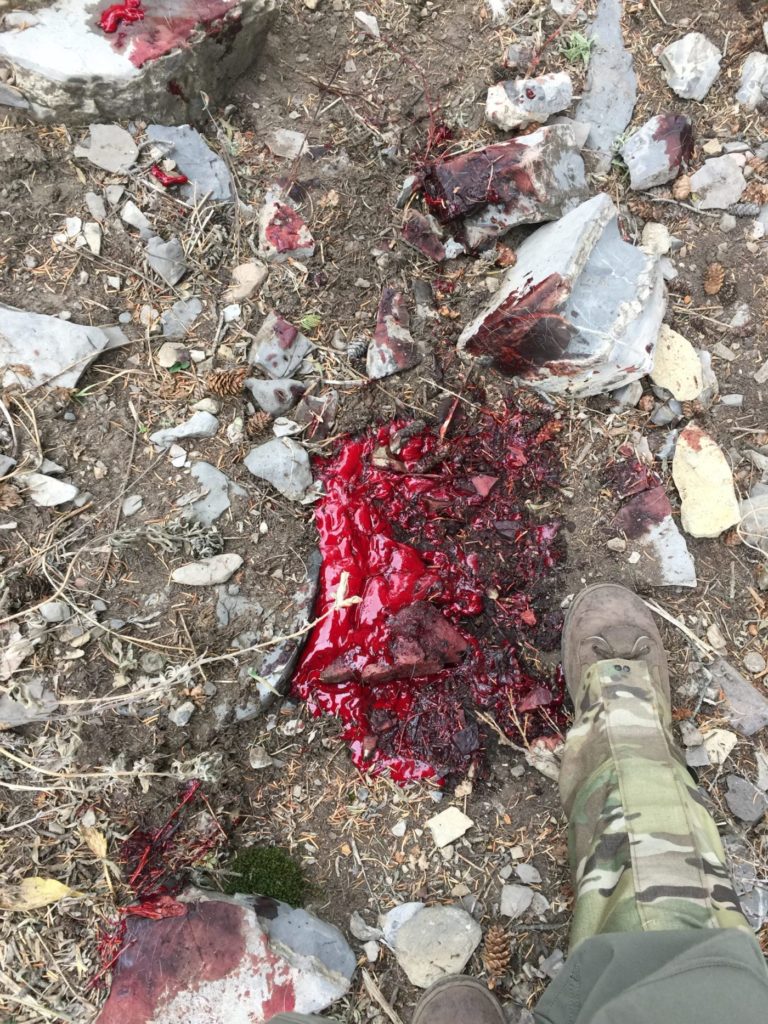“Help!”
That’s not what you want to hear. Not in these conditions: wet, cold, steep, rocky, and slippery as snot.
It was Steve. His yell for help was faint, but clear. He was in trouble.
As the cold rain drilled down on us, I looked at Goose. “Let’s leave our packs here and go help him.” Off we ran, back up the trail. I felt like I was walking on the moon after having that 90-pound pack on, but I was afraid I would have to carry a 180-pound man off the mountain instead. I crested a small bench and could see Steve’s headlamp in the distance. He was moving, which was good news. From his yell, I could have sworn he’d broken something.
“Steve, are you okay?!”
“Not really.”
“What’s wrong then? Are you hurt?”
The only response I got was the sound of a defeated man. “I couldn’t see you guys and I panicked. I didn’t know which way to go, so I yelled.”
Had it been daylight, no problem, he would have seen us, but when darkness came, a storm fell upon us and brought with it a dense fog. We literally couldn’t see more than 10 feet in front of us.
Steve hobbled down the hill toward us with his heavy pack, grunting and moaning each step of the way.
“We have to stick together the rest of the way,” Goose demanded. Usually Goose isn’t demanding like that. He hadn’t said much up to that point, but his message came through loud and clear: he was concerned.
He was right; it was too dangerous to be out in this storm alone; and in this case, due to the dense fog and heavy rain, being more than 50 feet apart from one another meant loneliness. Any one of us could slip and fall, spraining an ankle or breaking a bone. We had all fallen numerous times. It was like carrying a gorilla on your back, walking downhill, and stepping on all the banana peels he’d left behind.
I looked at my GPS. We had only gone a quarter of a mile! By the way the crow flies; we had over three miles left to go. It was going to be a long night.
In May 2015, the draw results for the upcoming hunts were sent out via email. “Unsuccessful” was my result for the General Buck Deer hunt. The same went for my hunting partner, my brother Emmett. However, my two brothers-in-law, Steve and Goose, both drew tags for my honey hole; at least I could go with them.
I enjoy hunting whether or not I’m the one with the tag. I could be Steve and Goose’s “guide” so to speak. I’d hike with them and spot deer, carrying nothing but my pack and optics.
They are both new to hunting. Steve had shot a couple of small bucks a few years back, but this would be Goose’s first year. We had all talked and agreed that I would take them since I knew the area. When the time to hunt got near, I proposed two options: 1) Hunt a canyon where there are a lot of deer, but smaller bucks; or 2) Hunt a new area I had discovered via digital scouting the previous year, but had never been, where I knew we would see bigger bucks but would have to work harder for them. Because of his competitive nature, I knew Steve would pick option 2; he gets pissed when he hears other gunshots during the hunt. Goose didn’t really know what to expect either way, so he said option 2 sounded good to him. I then started my scouting in earnest via aerial and topographic maps.
I had a specific spot picked out where Steve, Goose, and I would be when the sun lit up the mountain opening morning. It was a spot just below a peak that looked across a draw and into patches of pine trees that blended with some small cliffs. It had all the ingredients for finding big bucks. I had a really good feeling about it. I called it, “The Spot”.
The Spot sat right at the 10,000-foot mark and was perched at the upper-most part of a high-country basin. I was certain big bucks would be there and devised a plan for our hunting party:
The evening before opening morning, we would hike from the truck up a ridge that ran east to west up to the main ridgeline, a 2,000-foot elevation gain. We would then make camp and rest for the night. Hours before sunrise, we would wake up and hike south along the main ridgeline, ascending another 1,000 feet, until we arrived at The Spot. This plan was designed as to not let any big bucks in the canyon know we were coming for them.
Months later, and after obsessing over the plan and The Spot, the time had finally come, and we hit the road. We parked the truck just above 7,000 feet and even though we had a long journey ahead of us, we were giddy as schoolgirls when our boots hit the ground. But I also harbored feelings of anxiety. I think most hunters feel that when setting out to get the job done, especially in a new area. This anxiety isn’t bad, per se; it’s the good kind, which motivates us. But just like playing in a sporting event, when the pistons start firing, the edge is taken off, and instincts take over. You start to feel alive. Your brain is in overdrive, absorbing all of the sensations that nature freely gives, and processing these inputs with one goal in mind: harvesting your prey. I don’t know about the next hunter, but I live for these moments! I live to hunt. Putting my wits to the test, drawing on past experiences to assess situations presented, quickly resolving the best course of action, and then confidently executing what needs to be done.
Our hike from the truck started out in the foothills on an old 4×4 road that had been barricaded off with mounds of dirt to stop motorized traffic. Once the old, overgrown road ended, we continued into thick oak trees that covered the upper foothills. I was following game trails as best I could, keeping a bearing of the spine of the ridge we wanted to hike up. Then we hit thick oak brush. I was really hoping the brush would thin out further up so we didn’t have to do the ol’ “swim through the buck brush” thing, but the brush only got worse. Eventually we swam up to the spine; it was full body workout.
Upon arriving at the spine of the ridge, I assessed the topography. The south-facing slope was steep as all get out, littered with buck brush and sage. I wanted to stay on the spine of the ridge, meaning we’d have to climb up a few small cliffs, which, believe it or not, represented the easiest route up. Aside from that, it made for some cool photos.
We got after it. I had climbed a series of cliffy/rocky areas and Goose was right on my heels, but Steve was falling behind. His McDonald’s meal plan and his exercise routine on the couch were letting him down. After we climbed to the top of each cliff, we would stop to rest and enjoy the scenery, catch our breath, glass a little bit, and then keep moving. There were half a dozen or so of these small cliffy/rocky areas. At the top of one of the last cliffs, and while we were waiting for Steve, I remember pointing up to a saddle on the skyline and then to the corresponding location on the map, “We’ll camp there.” We had about 600 more vertical feet to climb. It was dusk, so we had about 20-30 minutes of light left. “We’ll get there right about dark,” I told Goose.
“Goose, give me some of your water.” Steve had caught up to us and was breathing hard; his face was flushed red with the look of fatigue.
“You’re already out of water?” I asked shockingly. “Well, hopefully we can find some run off from the snow up higher.”
I suddenly realized that we could potentially have a major problem. I didn’t know this area, and I was only hoping we would find a water source. Water had never been a problem in the other areas I had hunted in this mountain range. The aerial maps showed snow up high, but those images were taken in late spring from the looks of it. Crap.
Goose had plenty of water and shared some with Steve. Goose and I looked at each other and laughed. It was kind of comical in a way. Then I said, “Let’s keep going, it’s getting dark. We’ll set up camp and then I’ll go look for some water.”
Goose and I made it up to the top of the ridge just as darkness covered the mountain. I threw off my pack and headed further up the ridge to look for water. At this time I had about a liter left and I kicked myself for only bringing my two-liter water bladder; I should have brought my three-liter at the very least! Needless to say, I did not find any water. The mountain was dry. It was late October and it hadn’t snowed in a while. I was hopeful we would find some up near “The Spot” since it was higher in elevation, so maybe, just maybe, there was some snow or puddles.
I got back to where Steve and Goose were waiting. “No water,” I said. “Let’s set up the tipi and then make a game plan for tomorrow.” We put up the four-man tipi, inflated our pads, unrolled our sleeping bags, ate a light dinner and some snacks, laughed at Steve’s misfortune of running out of water, made our plan for the morning, and went to sleep.
“THUNDER, ahhh. Thunder, ahhh…” ACDC’s Thunderstruck, my choice of alarm on my phone, woke me from a dream about finding water. Seriously, this is no lie. I took it to be a good sign. It was 4:30 am.
The sun was to rise at 7:41. About 45 minutes before sunrise, shapes and outlines can be seen, and each minute thereafter brings more light. Because of this, we needed to be at The Spot no later than 7:15. Once we got up, broke down camp, and ate breakfast, it was about 5:00. We had two miles and 1,000 vertical feet to get done in two hours. No problem.
Our legs were a bit sore from the hike just hours before, but I had been hunting every weekend since September, so my legs were ready to go another day. Steve and Goose felt miserable, but once their muscles warmed up, they were okay. I knew they were okay because they were still excited and eager to find deer, and they were laughing. I had to remind them that even though it was dark, we were still hunting, and that deer can hear really well, and we had to be quiet and whisper if need be. I felt like a jerk, but these were rookie hunters and it was my job to teach them how to hunt, right?
The hike was great. The game trails through the timber were easy to hike, and there wasn’t any buck brush to swim through. We stopped to rest every so often; more often on the really steep parts, and progressively more often for Steve.
“Dude, I am so out of shape!” “Why did I eat at McDonald’s for every meal?” “I need to rest.” “I’m so thirsty.” “I’m getting light-headed.” These are the things Steve would say once he’d catch his breath. We still laugh to this day about that. Consequently, Steve adopted the nickname Ronald… for Ronald McDonald.
Finally, we had made it to the 10,000-foot mark, but now had to traverse a couple of small bowls to get to The Spot. Here is a picture of Steve’s condition at that time. He told us to go on without him and he would mosey on over in a bit.
With all the resting, we were pushing to get to our destination on time. Goose and I made quick work of the two bowls and got to The Spot. It was perfect! Right away I spotted some deer through my binoculars. Although it was hard to tell in the dim light, it was a doe and her fawn.
This was Goose’s first hunt, so I spent some time showing him where the doe and fawn were and then moved into a conversation about how to glass for deer and what to look for. We talked about a few places where he could start looking, like the clearings between patches of trees, or along the edge of trees, near water sources, along game trails, and then eventually in the trees themselves. Then we talked about what to look for, things like brown spots, gray spots, white spots, things that looked out of place, and especially for movement. I told him that he would eventually get the hang of it and his eyes would become trained. We started to look for more deer around the doe and fawn, which were in a flat clearing at the base of some timber patches across from us.
“I see some,” Goose said. “Up there on the skyline.”
There was no mistaking it. I quickly setup my spotting scope to get a closer look. A couple of three-point bucks and some does.
“Good job, Goose,” I told him. “Those bucks aren’t big enough, though. Let’s keep looking.”
I ranged the deer at about 600 yards away on the far ridge. “And they are too far to shoot right now.”
Goose was a pretty good shot; however, he had only practiced out to 300 yards. His first time shooting, a few weeks prior to the hunt, he shot a three-shot group that measured three and a quarter inches at 300 yards. Damned good for a rookie!
We continued to glass the area, looking for more deer. Almost immediately we spotted another group feeding on the skyline, but this time they were higher up on the ridgeline, almost to the top of the peak. It was a small group of deer: a decent four-point, a three-point (bigger than the ones we just saw), and a doe. They were about 500 yards away; still too far.
“We’ll keep looking, but that one buck is decent,” I told Goose. “Let’s hope they feed into the patch of trees below them. They’ll be closer and we’ll put together a plan.”
Just then my phone started buzzing; it was Steve.
“Hey Steve, what’s up?”
“Where are you guys?” He asked.
“We’re just down the hill from where the trail traverses over the ridge. We’ve spotted a few bucks.” I said. “I’ve got to go so I can keep tabs on them.”
We ended the call and kept looking at the deer. I took some freehand pictures of them through the spotting scope (I forgot my scope cam!).
A few minutes passed and the deer started running.
“Something spooked them,” I told Goose. Luckily, the deer ran into the trees we were hoping they would, putting them a couple hundred yards closer.
We could hear some movement above us. Excitedly, we turned around to look uphill to see what was causing the noise. It was Steve. I was half pissed, half laughing. I didn’t know if Steve was just making a rookie mistake by creating so much noise and giving away our position, or if envy got the best of him and he didn’t want to miss out on the action. Either way, I started multitasking: keeping tabs on the deer as they ran into a patch of pine trees, and quietly yelling at Steve to cool it.
Once we were all seated together, Goose and I filled Steve in on the location of all the deer we’d seen. I told them to use their binoculars and pick apart the patch of pine trees where the deer were hidden. I had an advantage with the spotter so I started scanning. I soon found a big two-point we hadn’t seen yet, the three-point, and the smaller four-point. The big two must have been in the trees the whole time, so I knew there were more deer in there. We kept looking.
We were on a group of bucks on the first day at first light. I could see the three-point clearly. He was bedded down and his body was not obscured by any trees. I decided he was a great first buck for Goose. It was Goose’s first hunt and we had a 340-yard shot. We’d practiced for this and the opportunity was presented.
I made the decision for him. “Okay, Goose. You’re gonna shoot the three-point. He’s a nice deer, and three-point bucks are cool.”
“Alright,” he said, a bit nervous.
“You’ve got this, man. I’ll set up a rest on this tripod to give you a steady aim.”
It took me about a minute to get the tripod rest set up. I had a V-yoke attachment in my pocket for use in situations like this. I took the spotter off of the quick release plate, attached the yoke to the plate, and then put the plate back onto the tripod.
“Goose. Sit here where I’m sitting. Rest your rifle on the yoke.” I instructed.
Goose got set up. He sat down, placed the fore-end of his rifle on the V, and got situated for the shot.
“Where is he?” Goose asked.
“Okay, see the cliffs near the top of the patch of trees?” I asked.
“Yeah.”
“Okay, go about 20 yards below the cliffs and you’ll see a fallen tree. See it?”
“Yeah.”
“Now go left about 10 yards. He was laying down on the right side of that big, dead, tree.”
“Okay, let me find that in the scope,” Goose said.
Not having the spotter on the tripod, I pulled my binoculars up to look at the buck. He was gone.
“Crap. He moved. He’s not there anymore. Let me find him again.”
I scanned the trees for movement. There were two bucks slowly feeding in a clear, rocky spot in the upper middle of the patch of trees. It was too hard to tell the size of the bucks with 10x binos.
“Goose, I’m gonna set up the spotter again to see which bucks those are.”
So I went through the whole “take the yoke off the quick release plate, attach the spotter to the plate, then put the spotter on the tripod” routine.
“The one on the left is the three-point. The one on the right is a nice four-point. Wow, he’s pretty good. Where did he come from?”
“Really!?” Steve piped up.
“Yeah, man. He’s the biggest one I’ve seen today,” I replied.
I had no idea what class this buck was in, but he was north of 150. This just goes to show how smart older bucks can be. He must have been hiding in the trees the whole time we were there and just now came out to feed. He quickly became Goose’s new target.
“Okay, Goose, let’s get you set up to shoot that four-point,” I said.
For the third time, I took the spotter off of the tripod and put on the yoke. By now it was very apparent that I needed to buy another quick release plate!
Goose got set up as the two deer fed from left to right across the rocky clearing. After aiding Goose in acquiring the buck in his scope, I started to talk Goose through the process of taking the shot.
“Remember to squeeze the trigger, just like we practiced. Take your time. Make sure you have a steady aim. Don’t rush it.”
I’m saying all of this while watching the buck through my binos. Right then the deer started feeding in a zig-zag pattern in a downhill direction. The four-point turned frontal.
“Okay, wait until he turns broadside. Don’t shoot yet,” I cautioned.
“Okay.” Goose understood.
“Alright, he’s broadside again,” giving my play-by-play.
I went through the reminders again. I’m sure Goose wanted me to just shut up, but I couldn’t help it. I had caught the fever and I was excited and anxious. I didn’t want this opportunity to be missed.
“Damn, he’s frontal again,” I said.
Steve offered some words, “I have a shot on the three-point.”
“Wait for Goose to shoot first,” I urged.
“Goose, he’s broadside again, but he’s heading into the trees, you’re going to have to be quick.” I was frantic. The four-point kept walking and his vitals were now covered by the limb of a bushy pine tree.
Damn.
I turned to Steve, “Okay, Steve. When you have a shot on the three, take it.”
Steve didn’t waste any time. Within three seconds, BOOM! The 325 short mag roared! The startled, but uninjured, bucks took a few leaps downhill and to the left, then stopped.
“Miss,” I called out.
They were standing in the lower left corner of the rocky clearing, side-by-side, broadside. Steve didn’t have a clear shot on the three-point as it was in the lead and half covered by a tree.
“Goose, the buck in the back is the four-point. Shoot it!” I said louder than I should have.
Goose understood the urgency of the situations and, like he saw Steve do, wasted no time. BOOM! Splat. It was the distinct noise of a gun firing and the bullet hitting its target.
“You hit him,” I said with a shaky tone in my voice. I was so excited for Goose. “He’s going down.”
Goose’s buck was hit and struggling to stand up. The strong and trusted legs of the mature buck were now feeble and weak; they could no longer conquer the sheer steepness of the mountain. The buck tumbled and gravity pulled him downhill into the trees, out of sight. However, before he disappeared, I could see the front legs struggling to steer his descent.
“Good job, Goose!” I exclaimed. “That was awesome! Nice shot!”
“Where did he go?” Goose asked.
“He rolled down into the trees,” Steve answered.
We sat there and talked about the experience, sharing with one another what was going through our heads. Goose was shocked, “Dude, that was fast! It all happened so quickly. Did he die?”
“Oh, I’m sure,” Steve said
“Yeah, man. His ass hit the dirt and he rolled downhill. Let’s go find him,” I said.
I looked over in the patch of trees to see if the other deer were still around. “The two-point is still lying there!” I said. I looked the patch of trees over and saw another-four point, but it wasn’t the small four. What the heck? Where were these deer coming from? I set up the spotter, again, to get a good look. He was gone. I looked up from the eyepiece and scanned the trees for movement. Bingo. Found him. He was sneaking out of the trees.
“Steve. There’s a nice buck sneaking out of the trees. Right there.” I pointed, thinking he’d see the movement.
“Where? I can’t see,” he said.
Goose chimed in, “I see it. It’s moving fast through the trees. He’s about to come out of them.”
The buck was getting out of Dodge. He’d just seen his buddy go down and wasn’t about to stick around. He was gracefully negotiating the rocky and steep terrain, even traversing the small cliffs effortlessly. These animals are amazing!
The buck stepped out of the north-facing trees and began trotting across the hill. The upper basin we were in was bowl-shaped. Although we weren’t totally aware of it because our attention was focused on helping Steve locate the buck, it was moving closer and closer to us in thanks to the contour of the mountain.
“Dude, Steve, he’s right in front of us. 200 yards.” I was getting impatient. Goose and I were literally shouting at Steve.
“Oh, I see him,” Steve finally spotted the buck.
All of this commotion gave away our position and the buck started hightailing up the bowl away from us.
We all have a noise we make when we attempt to stop a running deer in its tracks. Some people whistle, some yell; I “meh.” It sounds like a sheep, and it’s worked for me over the years.
“Meh…” The buck didn’t stop. “MEH!” I yelled. The buck stopped and looked at us, quartering to. “Hold right on his shoulder,” I reminded Steve. His gun was zeroed for 300 yards; holding right on the shoulder would easily place the bullet in the vitals.
BOOM! The 325 short mag roared again. The buck collapsed and immediately began rolling down the steep hillside. The rolling instantly turned into cartwheels and progressed into flips! We all watched in awe as this buck, flipped into the air and down the mountain.
“Oh, shoot!” Steve said, “He’s not stopping.”
Thankfully, the hillside was covered in thick sagebrush, which eventually slowed him down enough that he slid to a stop.
“Nice shot!”
We were ecstatic. We had just pulled a double-header on two nice deer in a matter of minutes. What a rush! The Spot turned out to be just what we were looking for. I won’t go so far as to call it “Buck Heaven,” but it’s definitely a main attraction on the way.
Again, we shared our excitement and thoughts with one another and then decided it was time to go retrieve the deer. We traversed the bowl a couple of hundred yards to Steve’s buck. Luckily his antlers didn’t break during the tumble because it was a beautiful buck. Thick, mature-looking antlers and a double throat patch! We admired its beauty.
“Steve — that is a nice deer. Congrats man!” I was so excited for Steve. This was his first harvest of a mature deer.
We took some pictures and Steve made a call to his wife to share the great news. Goose and I left Steve to field dress his buck while we went to find Goose’s deer.
We traversed the rest of the bowl and entered the patch of trees. Once in the trees, we had to climb across the face of a cliff. There were deer tracks in the dirt that had accumulated on this rocky passage over the years. This was no doubt the cliff that I had seen Steve’s buck cross just moments earlier. It was almost unbelievable that a deer could walk across such a narrow path, let alone run across it!
Once the cliff had been taken care of, we hiked up to the clearing where Goose’s buck was standing at the shot so we could find the blood trail. Right away we found blood, which wasn’t too hard to follow given that he had lost pools of it on a steep, zig-zagged game trail. The buck had kept to the trail after being hit, which made sense after remembering that he was going down the hill with front legs kicking.
“Goose, there is a huge pile of chunky blood over here.” Goose came over to me and saw the massive pool of blood. It looked like part of an organ was sitting there. “This guy lost so much blood, he’s for sure dead. He’s got to be straight down now.” The zig-zag trail had stopped. It was literally a 45-degree slope at that point.
TO BE CONTINUED NEXT MONTH…



